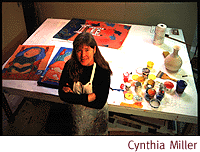
Painter Cynthia Miller Loads Up On Real Life And Art.
By Margaret Regan
CYNTHIA MILLER, the local artist much-admired for paintings
that give eccentric life to household objects, had repaired to
her own domestic headquarters in between engagements.
Just back from a shopping expedition to Penney's, where she'd
bought new sandals for her two young daughters--one pair of white,
one pink--in half and hour Miller had to be over at the elementary
school for a meeting of the fine arts committee. At home in between,
she fried up burgers, nuked a trio of burritos, shooed off the
dog, fended off a telephone solicitor, hugged a child who'd fallen
off a swing and pondered questions about her painting.
 "It would be helpful to have two brains," she said
cheerfully in response to a query about balancing her life as
an artist and as a mother. "The mother brain never shuts
off."
"It would be helpful to have two brains," she said
cheerfully in response to a query about balancing her life as
an artist and as a mother. "The mother brain never shuts
off."
Miller's latest paintings, joyous mixed-media affairs full of
loopy painted chests and maverick prickly pears, are in a group
show at Pima Community College, along with Rudolph Nadler's geometric
abstractions and Julia Andres' metallic vegetable sculptures.
On her last outing, at the Temple Gallery more than a year ago,
Miller showed affectionate paintings of little girls and childhood
treasures, painted in a flat, deliberately naïve style.
"I never really got away from the chests," she said,
"but I had to do the kid thing. For now the furniture is
calling."
Miller maintains that "it's a mystery to me where (the images)
come from," though her subjects have a curious habit of following
her own life. The ironic Domestica series on household
objects, for instance, more or less coincided with her marriage.
The kid paintings emerged after an "enforced break"
of several years from serious work on her art, during which Miller
was mostly a full-time mom. She'd had neck surgery (she'd been
injured hauling her huge canvases around) and given birth to her
second child. Then the family had moved out of Miller's native
Southwestern habitat to the cold clime of Minnesota for a job
for her husband, poet and Chax Press publisher Charles Alexander.
"I felt I was moving to the moon," she said. "I
felt like a refugee...You don't get vistas there." Sometimes,
when she'd be traversing a vast mall parking lot, she said, "I
would hallucinate the Catalinas."
And after years of being in the thick of things on the Tucson
art scene--studying at the UA, helping found Dinnerware--in Minneapolis
Miller found herself in the more typical artist's position: on
the outside looking in. Her friends, she said, were the other
moms and dads on the block, and a surprising number of them were
trained artists who had abandoned art in favor of work that could
actually support them.
 "It made me mad," she said. "Art doesn't do enough
for people. It was amazing how little of what was happening (in
Minneapolis) was set up for people."
"It made me mad," she said. "Art doesn't do enough
for people. It was amazing how little of what was happening (in
Minneapolis) was set up for people."
But her artist's eye didn't stop looking, and Miller acknowledges
some new northern influences in her work, even though the family
returned a year and a half ago to her home place of hot Mexican
pinks and "velvety blue" summer skies.
"My colors have gotten softer," she said. "There's
so much water up there the light acts differently. It's kind of
a reflective light...Before I did a lot of bright Mexican colors...Now
I find I like what muddy does."
Still, in her current suite of seven works, one would be hard
pressed to find any hues that deserve the appellation of muddy.
"Snow Box," a 1998 work on paper of acrylic, chalk,
oil pastel and oil paint stick, pulses with orange, pink and blue-green.
(The yellow "snowflakes" on the chest of drawers look
suspiciously like Hohokam spirals.) "Monsoon Chair,"
a 1997 mixed-media work on paper, has the exact dark blue of the
summer evening sky, and the pads of its prickly pears glow a deep
green. This piece also features another Miller trademark: a tiny
child's chair of straw and wood, gaily painted in flowers.
"I did that first series of little chairs in 1991, when
we first got involved in the Persian Gulf War," said the
artist, shaking her head. "And now...it's come back again."
Her painted chests of drawers, all curving lines and impossible
angles, are pure "Toon Town," she says. "Nothing
is square. The Alamo guys (fine furniture makers whose workshop
adjoins her studio in the Steinfeld Warehouse) give me a hard
time."
"None of the pieces are real," she added, "though
they have references to real things and references to real people...The
furniture has an intensity, like a body, and the layering of materials
gives them their own history."
Miller's ruminations were interrupted by a small pink sandal
hurled with deadly accuracy across the living room. Time for the
art brain to cede to the mother brain. The painter began dashing
around, ordering shoes put on for the outing to school, and crayons
and paper and books assembled to ward off the meeting fidgets.
But she paused for one more thought about art and family:
"I'm trying to pace myself, but I didn't have any idea (what
motherhood would be like)...They still haven't written the book
on it. But having a family is a real adventure artists can participate
in."
An exhibition of a paintings by Cynthia Miller and Rudolph
Nadler, and sculpture by Julia Andres, continues through
Monday, February 16, at the PCC Center for the Arts gallery, 2202
W. Anklam Road. Gallery hours are 10 a.m. to 5 p.m. Monday through
Friday. For more information, call 206-6942.

|





